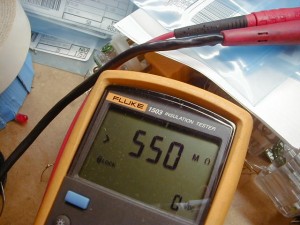[veer alert]I challenge the idea of "body capacitance" here. Where is this capacitance "in the circuit" ? Between "Ground" and ????
The significant effect is that your body is a noise source when it is electrically floating.
When you touch "Ground" (typically by being in contact with the grounded metal parts/strings on a guitar) your body is held at the same potential and ceases to be a source of noise. You could also touch any other grounded metal for a similar effect - equipment rack / metal chassis etc. And it can be useful to arrange such a connection to your body to avoid noise when you might lose connection via the guitar due to playing technique. tapewound or coated strings etc.
I have had people doubt, or full out deny the body as a noise source. I tell them to touch the tip of a 'scope probe and observe the distorted 50Hz waveform on the trace. (60Hz if that is your mains frequency but it doesn't sound as good).
And if you get a periodic noise at one second intervals - it's your watch (yep - been there)
During the design of my OD-1 outlet tester http://www.johnhroberts.com/OD1.htm I spent a lot of time investigating the electrical characteristics of an ungrounded human body. The classic problem for outlet testers is "voltage relative to what?". To identify hot-energized leads for outlet testing my OD-1 uses the human body connected through a touch probe to be a relative 0V AC reference. For this to work and have any chance of being UL approved, the human touch contact has to be extremely high impedance. I accomplished that with a mosfet input buffer (schematic available at the link). I measured my testers input impedance as >500M Ohm at 500V with a commercial tester.

I abandoned this project even though I believed it "could" pass UL safety criteria, but that would likely involve opening a file with UL and paying them tens of $k to confirm the safety of my design. But after that sunk cost I have a SKU that needs to retail for <$20 and convince inexperienced customers that its OK to touch a metal probe while testing outlets.
Long story short and back on topic, I found that the human body served as an adequate 0VAC reference for comparison testing to mains voltage. So indeed the human body is floating but has some apparent capacitance relative to the local environment (ground?. I have not attempted to specifically characterize how much capacitance the human body contains, only that there was enough for my outlet tester to work.
[edit- Capacitive touch switches appear to work using body capacitance so may have done more rigorous research than I did. /edit]
JR
Last edited:


























![Soldering Iron Kit, 120W LED Digital Advanced Solder Iron Soldering Gun kit, 110V Welding Tools, Smart Temperature Control [356℉-932℉], Extra 5pcs Tips, Auto Sleep, Temp Calibration, Orange](https://m.media-amazon.com/images/I/51sFKu9SdeL._SL500_.jpg)









